Top 10 Motorcycle Maintenance Fails
Like human bodies, motorcycles can take a lot of abuse and keep on running. But there are some sure-fire ways to screw up your motorcycle, often done through a combination of ignorance, incompetence and neglect. Treat your motorcycle right and it will do the same for you.
1. Not Maintaining Proper Tire Pressure
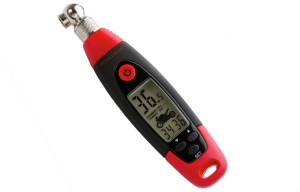
Roadgear Programmable Digital Tire Gauge
Motorcycles, cars, trucks, you name it—there are millions of vehicles out on the road with under-inflated tires, which reduces gas mileage and makes the tires run hot, shortening their lifespan. (You can also over-inflate tires, but it’s less common.) Some people check their tire pressure before every ride—not a bad idea, especially if you’re on a multi-day tour—but do it at least once a week or at every fill-up. Check your tires when cold, use your own tire gauge (keep one in your toolkit or saddlebag) and follow inflation guidelines printed on the VIN plate on your bike or in the owner’s manual (#10). When checking tire pressure, also inspect for foreign objects that may be stuck in your tires and for signs of wear or other damage.
Read our review of the Roadgear Programmable Digital Tire Gauge
2. Wasting Money on Premium Fuel When Your Bike Doesn’t Need It
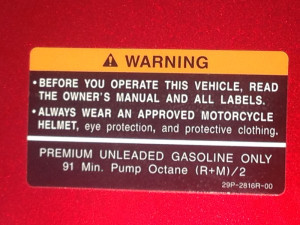
This motorcycle requires 91 minimum PON (octane).
Your bike’s owner’s manual (#10) or a sticker on the fuel tank will tell you the minimum octane fuel (PON, or pump octane number) that your motorcycle requires. Many of today’s motorcycles require premium fuel (typically 90 PON or higher), but some modern motorcycles and many older ones require only regular fuel (usually 86 or 87 PON). Running lower-than-recommended octane fuel is very bad; it can cause detonation (knocking) and potentially damage the engine. Running higher-than-recommended octane fuel wastes money at the pump (don’t fall for the gasoline companies’ marketing about high-octane fuel being “better”; it won’t boost performance and the EPA requires all fuel grades to have engine-cleaning detergent additives), and it can reduce gas mileage.
3. Not Regularly Checking and Changing the Oil
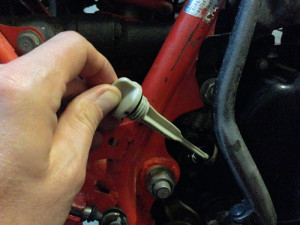
This motorcycle has a dipstick for checking oil level; others have a sight glass.
All internal combustion engines have reciprocating metal parts that require proper lubrication to reduce friction and heat. Some engines, especially older ones with worn seals, gaskets and piston rings, will consume oil, either by burning it up in the combustion chamber or simply leaking out. Get in the habit of checking your oil level—some motorcycles have sight glasses, others have dipsticks—every time you fill up the gas tank. And refer to your owner’s manual (#10) for the recommended oil change interval (in miles and/or months). Oil filters collect dirt, debris and metal particles, so make sure to install a new oil filter when you change the oil.
4. Forgetting to Clean, Lube and Adjust the Chain

The black tube hanging from the swingarm is the Scottoiler chain oiler.
If your motorcycle has chain final drive, neglecting to clean, lubricate and adjust the chain is asking for trouble. (Drive belts don’t need to be lubricated, but they should be regularly inspected for wear and proper adjustment.) If you have an older bike it may have a non-sealed chain (which requires more care and maintenance), but most contemporary motorcycles have O-ring chains, which have small rubber O-rings between the link plates and rollers that help keep lube in and dirt out. Most owner’s manuals recommend lubricating the drive chain every 400-500 miles, but if you ride in wet or dirty conditions, you should lube the chain more often, perhaps every day. If possible, before adding lube, clean the chain with a non-wire brush and mild soap. Lubricate the chain after a ride, when the chain is warm, to help the lube penetrate the small spaces between the O-rings, plates and rollers, and use a dedicated motorcycle chain lube, such as Spectro Oils Z-Clean Chain Lube. With the bike in neutral and up on its centerstand or a rear-wheel paddock stand, spin the rear wheel forward and spray the lube on the top of the lower chain, just before it comes in contact with the rear sprocket. Wipe off any excess and spin the rear wheel a few more times to help the lube work its way in. Once the chain has been cleaned and lubed, check for proper chain tension, make any necessary adjustments and check the chain and sprockets for wear.
Read our Scottoiler Chain Oiler eSystem review
5. Not Using Fuel Stabilizer or Draining the Carbs During Short-Term Storage
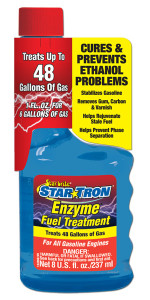 Those of you with fuel-injected bikes, count yourselves lucky and move on. But if your motorcycle has carburetors and it sits for more than a couple of weeks between rides (hello, winter!), it’s teeny-tiny jets and other parts can become clogged or gummed-up by old fuel that breaks down over time and creates sticky varnish. Regularly using a fuel stabilizer such as StarTron and draining the carburetor’s float bowl after a ride when the bike will be parked for a while (the easiest way is to turn the fuel off and let the bike run in neutral until it conks out) are the best ways to protect your carbureted fuel system against the scourge of today’s ethanol-blended gasoline.
Those of you with fuel-injected bikes, count yourselves lucky and move on. But if your motorcycle has carburetors and it sits for more than a couple of weeks between rides (hello, winter!), it’s teeny-tiny jets and other parts can become clogged or gummed-up by old fuel that breaks down over time and creates sticky varnish. Regularly using a fuel stabilizer such as StarTron and draining the carburetor’s float bowl after a ride when the bike will be parked for a while (the easiest way is to turn the fuel off and let the bike run in neutral until it conks out) are the best ways to protect your carbureted fuel system against the scourge of today’s ethanol-blended gasoline.
Read about more about “Fuel Stabilizers and Short-Term Storage”
6. Forgetting to Lube and Adjust the Throttle, Clutch and Brake Cables
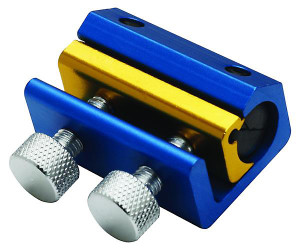
Motion Pro Cable Luber
The control cables that actuate the throttle, clutch and brakes are absolutely critical components that are often overlooked, a simple matter of “out of sight, out of mind.” A sticky cable that doesn’t move back and forth properly can be dangerous, and a broken cable can leave you stranded in the middle of nowhere. According to Motion Pro, which makes a wide variety of motorcycle tools, cables and controls, motorcycle control cables should be lubricated and adjusted at least once per riding season and more frequently for dual-sport and off-road bikes that see much more wear and tear. We recommend reading Motion Pro’s handy how-to guide “Cable Maintenance 101.” Motion Pro also makes a handy Cable Luber ($9.99) and sells Cable Lube ($15.99 for a 6 oz. can).
7. Not Using a Battery Maintenance Charger
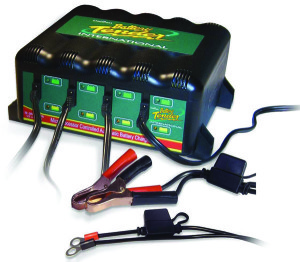
Deltran Battery Tender 4-Bank Motorcycle Charger
Even if your bike is parked safely in the garage, over time its battery will self-discharge. Allowing the battery to discharge can lead to sulfation—the build-up of lead sulfate crystals—which can result in a loss of cranking power (your bike won’t start), longer charging times and, ultimately, shorter battery life. The best way to keep your motorcycle’s battery healthy is to use a smart maintenance charger such as a Deltran Battery Tender. It has “microprocessor controlled power electronic circuitry” which enables it to perform and control various charging functions, including battery testing, bulk charging and float/maintenance charging to keep the battery in optimal condition.
Read our review of the Deltran Battery Tender 4-Bank Motorcycle Charger
8. Not Checking and Changing the Final Drive Oil

Shaft drive on our Yamaha Super Ténéré ES long-term test bike.
Many touring riders love motorcycles with shaft final drive because of their cleanliness and low maintenance. Although heavier than chain final drive, shafties don’t fling chain lube onto the swingarm or rear fender and they don’t need to be adjusted or replaced like chains and sprockets. But the gears inside shaft drives are lubricated with oil that needs to be checked regularly (in case there are leaks or it has become contaminated) and changed according to the recommended service interval in the owner’s manual (#10). Our Yamaha Super Ténéré ES long-term test bike, for example, needs its final drive gear oil changed during the initial break-in service (at 600 miles) and every 16,000 miles thereafter. That’s a long enough interval to easily forget about or ignore, but the consequences can be very costly—replacing a damaged final drive is much more expensive than replacing a chain and sprockets.
9. Not Changing the Brake Fluid
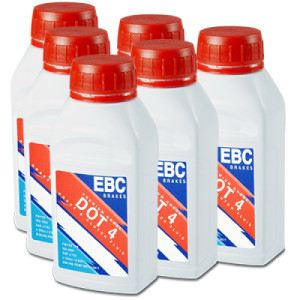
EBC Brakes DOT 4 Brake Fluid
This is another one that’s easy to overlook. Hydraulic brakes work extremely well, especially modern triple-disc systems with ABS, but for brakes to work properly the hydraulic fluid must be changed regularly. Glycol-ether (DOT 3, 4, and 5.1) brake fluids are hygroscopic, which means they absorb moisture, which contaminates the fluid over time. Most motorcycle owner’s manuals (#10) recommend changing brake fluid every two years and replacing the brake hoses every four years. Sticking to these service intervals, as well as checking and replacing your brake pads as needed, are critical for the safe and optimal operation of your motorcycle.
Read our DP Brakes Sintered Brake Pad review
10. Not Reading the Owner’s Manual
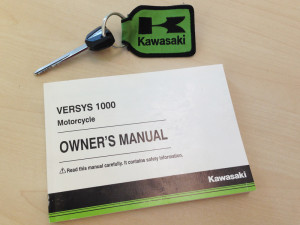
We keep the owner’s manual for our Kawasaki Versys 1000 LT long-term test bike under the seat.
There are a lot of references to #10 in this list because your motorcycle owner’s manual is an important source of maintenance information. Very few people read their owner’s manual cover-to-cover, but it’s a good idea to at least flip through it and become familiar with its contents. Most owner’s manuals have sections on safety, general information, specifications, routine maintenance/adjustment, troubleshooting, warranty information and a maintenance/service log. Your owner’s manual contains information about proper tire pressure (#1), fuel type (#2), checking and changing oil (#3), load capacity, suspension settings and much more. If possible, keep your owner’s manual on your bike (under the seat or in a saddlebag), sealed in a durable plastic bag. Buying the service manual for your particular model is also a good idea; keep it in your garage with your tools for handy reference.
Source: www.ridermagazine.com
